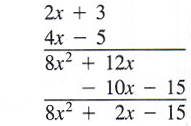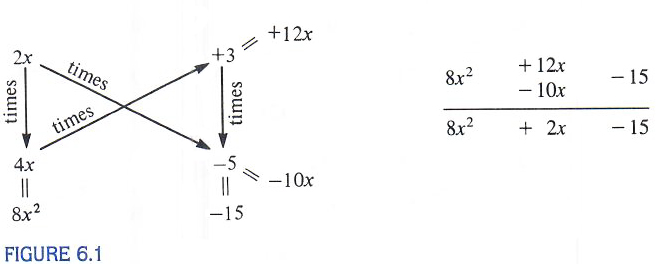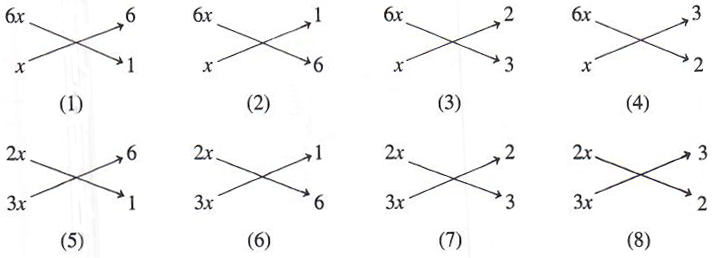Factoring Polynomials
When numbers are multiplied together, each of the numbers multiplied to get the product is called a factor. Sometimes it is desirable to write a polynomial as the product of certain of its factors. This operation is called factoring. Here we are interested in factoring polynomials with integral coefficients.
A polynomial is said to be factored completely if it is expressed as the product of polynomials with integral coefficients, and no one of the factors can still be written as the product of two polynomials with integral coefficients.
Following is a discussion of factoring some special polynomials.
Factors Common to All Terms
The greatest common factor (GCF) of a set of integers is defined as the greatest integer that divides each number of that set of integers.
The GCF can be obtained as follows:
1. Factor the integers into their prime factors.
2. Write the factors in the exponent form.
3. Take the common bases each to its lowest exponent.
Example
Find the GCF of 30, 45, 60.
Solution
30 = 2*3*5
45 = 3^2*5
60 = 2^2*3*5
The common bases are 3 and 5.
The least exponent of 3 is 1 and of 5 is 1.
Hence the GCF = 3^1*5^1 = 15.
The greatest common factor of a set of monomials can be found by taking the product of the GCF of the coefficients of the monomials and the common literal bases. each to its lowest exponent.
Example
Find the GCF of 9x^(3)y^(2), 12x^4y, -15x^5.
Solution
9x^3y^2=3^2x^3y^2
12x^4y=2^2*3x^4y
-15x^5=-3*5x^5
The common bases are 3 and x.
The least exponent of 3 is 1 and of x is 3.
Hence the GCF = 3x^3.
Example
Find the GCF of 6a^4(x - y)^2, 9a^3(x - y)^3, 12a^2(x - y)^4.
Solution
6a^4(x - y)^2=2*3a^4(x-y)^2
9a^3(x - y)^3=3^(2)a^(3)(x-y)^3
12a^2(x - y)^4=2^2*3a^2(x-y)^4
The common bases are 3, a, and (x - y).
The least exponent of 3 is 1, of a is 2, and of (x - y) is 2.
Hence the GCF = 3a^2(x - y)^2.
Note Since (1 - x)=-(x - 1), the GCF of a(x - 1), b(1 - x) is either (x - 1) or (1-x).
When the terms of a polynomial have a common factor, the distributive law,
ab_1+ab_2+ab_3+...+ab_n=a(b_1+b_2+b_3+...b_n)
is used to factor the polynomial. One factor is the greatest common factor of all the terms of the polynomial. The other factor is the entire quotient, obtained by dividing each term of the polynomial by the common factor; that is,
ab_1+ab_2+ab_3+...+ab_n=a((ab_1)/a+(ab_2)/a+(ab_3)/a...+(ab_n)/a)
=a(b_1+b_2+b_3+...b_n)
Example
Factor the expression 3a^2 - a.
Solution
The greatest common factor is a.
3a^2 - a = a((3a^2)/a-a/a)
= a(3a-1)
Example
Factor the polynomial 6x^(3)y^(2) + 12x^(2)y^(2) - 24xy^(2).
Solution
The greatest common factor is 6xy^2.
6x^(3)y^(2) + 12x^(2)y^(2) - 24xy^(2) = 6xy^2((6x^(3)y^(2))/(6xy^2)+(12x^(2)y^(2))/(6xy^2)-(24xy^2)/(6xy^2)
= 6xy^2(x^2+2x-4)
Example
Factor the polynomial 4x^2(2x - 1) - 8x(2x - 1)^2.
Solution
The greatest common factor is 4x(2x - 1).
4x^2(2x - 1) - 8x(2x - 1)^2 = 4x(2x - 1)[(4x^2(2x-1))/(4x(2x-1))-(8x(2x-1)^2)/(4x(2x-1))
= 4x(2x-1)[x-2(2x-1)
= 4x(2x-1)[x-4x+2
= 4x(2x-1)(2-3x)
This is how our factorization calculator solves the problem above. You can see similar problems solved by clicking on 'Solve similar' button.
Factoring a Binomial
The methods of factoring polynomials will be presented according to the number of terms in the polynomial to be factored.
A monomial is already in factored form; thus the first type of polynomial to be considered for factoring is a binomial. Here we shall discuss factoring one type of binomials.
Squares and Square Roots
The squares of the numbers 3, 5^2, a, x^2, and b^3
are, respectively, 3^2, 5^4, a^2, x^4, and b^6
The 3, 5^2, a, x^2, and b^3 are called the square roots of 3^2, 5^4, a^2, x^4, and b^6, respectively.
The square root of a number a is denoted by ![]() . The √ is called a radical sign, the 2 is called the index, and the a is called the radicand. When there is no index written, the index 2 is implied.
. The √ is called a radical sign, the 2 is called the index, and the a is called the radicand. When there is no index written, the index 2 is implied.
Although the square of both (+ 3) and (- 3) is 9, when we talk about the square root of 9, we will mean the positive number 3 and not the negative number (-3).
Definition
A number is said to be a perfect square if its square root is a rational number.
The square root of a specific number can be found by factoring the number into its prime factors, writing it in the exponent form, and then taking each base to one-half of its original exponent (when we square a number, we multiply its exponent by 2).
Examples
1. root(64) = root(2^6) = 2^3 = 8
2. root(144) = root(2^(4)*3^(2) = 2^2*3^1 = 12
Definition
When a is a literal number and n {is-in} N, we define root(a^(2n)) as (root(a))^(2n) = a^n. If the exponent is not divisible by 2, the number is not a perfect square.
Examples
1. root(a^4) = a^2
2. root(x^(2)y^(6)) = xy^3
3. root(4x^(2)y^(4)) = 2xy^2
The numbers 2, 3, 5, 7, 8, 10 etc., are not perfect square numbers. This means there are no rational numbers whose squares are 2, 3, 5 etc.
Definition
The square roots of numbers that are not perfect squares are called irrational numbers.
Difference of Two Squares
The product of the two factors (a + b)(a - b) is a^2 - b^2, the difference of two perfect square terms. The factors of the difference of two squares are the sum and difference of the respective square roots of the two squares.
Example
Factor 9a^2-4
Solution
The square root of 9a^2 is 3a and of 4 is 2.
Hence 9a^2 - 4=(3a + 2)(3a - 2)
Note Remember to factor the polynomial completely.
Example
Factor completely x^4 - 81y^4.
Solution
x^4 - 81y^4 = (x^2+9y^2)(x^2-9y^2)
= (x^2+9y^2)(x+3y)(x-3y)
Note Before checking if the binomial is a difference of two squares, check for a common factor. That is always the first operation to be performed.
Example
Factor completely 6x^4 - 6.
Solution
6x^4 - 6 = 6(x^4-1)
= 6(x^2+1)(x^2-1)
= 6(x^2+1)(x+1)(x-1)
Note (a + b)(a - b) = (a - b)(a + b)
Factoring a Trinomial
Factoring trinomials is divided into two cases:
1. When the trinomial is of the form x^2 + bx + c, b, c ∈ I, b!=0, c!=0.
2. When the trinomial is of the form ax^2 + bx + c, a!=1, a, b, c ∈ I, b!=0, c!=0.
Trinomials of the Form ![quadratic with no leading coefficient]() , b, c ∈ I, and b ≠ 0, c ≠ 0
, b, c ∈ I, and b ≠ 0, c ≠ 0
Consider the following products:
(x+m)(x+n) = x^2+(m+n)x+mn
(x-m)(x-n) = x^2 + (-m - n)x + mn
(x+m)(x-n) = x^2+(m-n)x-mn
(x-m)(x+n) = x^2 + (-m + n)x - mn
We note the following relations between the products and their factors:
1. The first term in each factor is the square root of the square term in the trinomial.
2. The product of the second terms of the factors is the third term in the trinomial.
3. The sum of the second terms, signed numbers, is the coefficient of the middle term in the trinomial.
Note To find the second terms in the factors, look for two signed numbers whose product is the third term in the trinomial and whose sum is the coefficient of the middle term in the trinomial.
Note When the sign of the third term in the trinomial is plus, the two signed numbers have like signs and are the same as the sign of the middle term in the trinomial.
Note When the sign of the third term in the trinomial is minus, the two signed numbers have different signs, and the larger one numerically has the sign of the middle term in the trinomial.
Example
Factor x^2+8x+15
Solution
The first term of each factor is root(x^2) = x
Hence x^2+8x+15 = (x )(x )
Since the sign of the last term (+15) is plus, the two signed numbers in the factors have like signs.
Since the sign of the middle term (+8x) is plus, the two signed numbers are positive.
x^2+8x+15 = (x+ )(x+ )
We look for two natural numbers whose product is 15 and whose sum is 8. The two numbers are 3 and 5.
Hence x^2+8x+15= (x+3)(x+5)
Example
Factor x^2-10x+24
Solution
The first term of each factor is root(x^2) = x
Hence x^2-10x+24 = (x )(x )
Since the sign of the last term (+24) is plus, the two signed numbers in the factors have like signs.
Since the sign of the middle term (-10x) is minus, the two signed numbers are negative.
x^2-10x+24 = (x- )(x- )
We look for two natural numbers whose product is 24 and whose sum is 10. The two numbers are 4 and 6.
Hence x^2-10x+24 = (x-4)(x-6)
Example
Factor x^2-5x-36
Solution
x^2-5x-36 = (x )(x )
Since the sign of the last term (-36) is minus, the two numbers in the factors have different signs.
x^2-5x-36 = (x+ )(x- )
Since the sign of the middle term (-5x) is minus, the numerically larger number has the negative sign.
x^2-5x-36 = (x + smaller number)(x - larger number)
We look for two natural numbers whose product is 36 and whose difference is 5. The two numbers are 4 and 9.
Hence x^2-5x-36 = (x + 4)(x - 9)
You can check below how our factorization calculator factorize the trinomial above. You can see similar problems solved by clicking on 'Solve similar' button.
Example
Factor x^2+3x-28
Solution
x^2+3x-28 = (x )(x )
Since the sign of the last term (-28) is minus, the two numbers in the factors have different signs.
x^2+3x-28 = (x+ )(x- )
Since the sign of the middle term (+3x) is plus, the numerically larger number has the plus sign.
x^2+3x-28 = (x + larger number)(x - smaller number)
We look for two natural numbers whose product is 28 and whose difference is 3. The two numbers are 4 and 7.
Hence x^2+3x-28 = (x+7)(x-4)
Example
Factor (x - y)^2 - 3(x - y) - 10.
Solution
(x - y)^2 - 3(x - y) - 10 is of the form a^2 - 3a - 10, whose factors are (a - 5)(a + 2).
Hence (x - y)^2 - 3(x - y) - 10 = [(x - y) - 5][(x - y) + 2
= (x-y-5)(x-y+2)
Note When the third term of the trinomial is a large number and its factors are not obvious, write the number as the product of its prime factors; then make products
of factors using combinations of the primes.
Note (x + a)(x + b) = (x + b)(x + a)
Trinomials of the Form ![quadratic with all coefficients]() , a ≠ 1, a, b, c ∈ I, b ≠ 0, c ≠ 0
, a ≠ 1, a, b, c ∈ I, b ≠ 0, c ≠ 0
Consider the product
(2x + 4)(x + 3) = 2x^2 + 10x + 12
The first factor on the left contains the common factor 2:
2x + 4 = 2(x + 2)
Also, the expanded product contains the common factor 2:
2x^2 + 10x +12 = 2(x^2 + 5x + 6)
In general, if a factor of a product contains a common factor, then the expanded product will also contain that common factor.
On the other hand, if no factor in a product, (x + 5)(3x - 2), contains a common factor, then the expanded product, 3x^2 + 13x - 10, will not have a common factor. Conversely, if the terms of a product do not have a common factor, then neither will any of its factors.
In order to learn how to factor a trinomial of the form ax^2 + bx + c, let us first look at how we multiply two factors together to get a product of this form.
We multiply (2x + 3)(4x - 5) as follows:

Let us go over the same multiplication again, as shown in Figure 6.1.

The crossed arrows  we will refer to as scissors.
we will refer to as scissors.
On the left side of the scissors,  are factors of 8x^2, the first term of the trinomial.
are factors of 8x^2, the first term of the trinomial.
On the right side of the scissors,  are factors of -15, the third term of the trinomial.
are factors of -15, the third term of the trinomial.
The sum of the products in the direction of the arrows,

is the middle term of the trinomial.
The following example illustrates how to use the scissors in factoring a trinomial
ax^2+bx+c, a!=1, a, b, c ∈ I.
Example
Factor 6x^2-5x-6.
Solution
Find all possible pairs of factors whose product is the first term of , the trinomial; each factor must contain the square root of the literal number. Write these factors at the left side of the scissors.

Find all possible pairs of factors whose product is the third term of the trinomial, disregarding the signs, and write them at the right side of the scissors.
Write all possible arrangements using the factors of the first term and the factors of the third term.

The eight scissors just shown give all possible arrangements of the factors of the first term of the trinomial and the factors of the third term of the trinomial.
The terms on top of the scissors form the first factor of the product, and the terms on the bottom of the scissors form the second factor of the product.
Since there is no common factor in the trinomial. there should not be a common factor between the terms at the top of the scissors or a common factor between the terms at the bottom of the scissors. If there is a common factor between the terms at the top or the terms at the bottom in an arrangement. that arrangement cannot be the correct one. Arrangements (1), (3), (4), (5), (6) and (7) have common factors, and we eliminate them.
The candidates are now limited to two arrangements.

The middle term of the trinomial. which is the sum of the products in the direction of the arrows. will indicate which arrangement is the correct one.
Since the first arrangement gives x and 36x for the middle term, which cannot give a sum of -5x, the first arrangement is not the correct one. The second arrangement gives 9x and 4x for the middle term, and by taking the 9x with a minus sign and 4x with a plus sign, we get -9x + 4x = -5x.
Hence the correct arrangement is

The factors of the first term of the trinomial are always taken positive. Thus, in order to arrive at -9x, the 3 at the right side of the scissors has to be taken negative while the 2 has to be taken positive to arrive at +4x. The complete arrangement is

Hence 6x^2 - 5x - 6 = (2x - 3)(3x + 2)
Note When the trinomial has a common factor, factor it first before you attempt factoring by the scissors.
Note There is no reason to write any arrangement with a common factor between the top terms or a common factor between the bottom terms.
Note When the coefficient of the first term, or the third term of the trinomial is a large number, write the number as the product of its prime factors, and form products of factors using combinations of the primes.
See how our factorization calculator solve the trinomial above. You can see similar problems solved by clicking on 'Solve similar' button.
Example
Factor 6x^2+19x+15.
Solution

Hence 6x^2+19x+15 = (2x+3)(3x+5)
Example
Factor 36x^4-241x^2+100.
Solution

Hence 36x^4-241x^2+100 = (4x^2-25)(9x^2-4)
= (2x+5)(2x-5)(3x+2)(3x-2)
 , b, c ∈ I, and b ≠ 0, c ≠ 0
, b, c ∈ I, and b ≠ 0, c ≠ 0 , a ≠ 1, a, b, c ∈ I, b ≠ 0, c ≠ 0
, a ≠ 1, a, b, c ∈ I, b ≠ 0, c ≠ 0